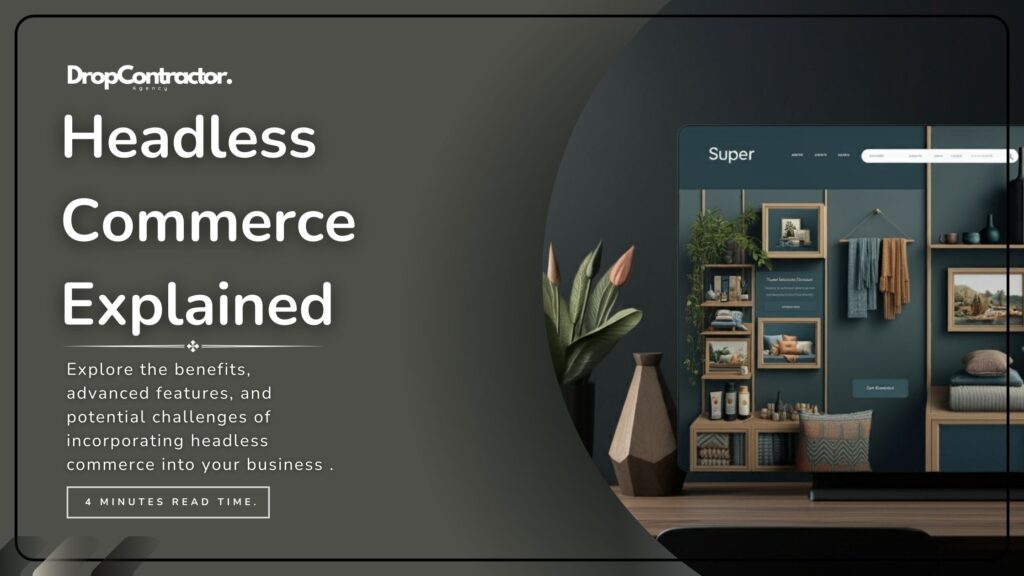Introduction
Imagine a restaurant. The kitchen (the back-end) prepares the food. But how that food reaches you (the front-end) can be different: you might eat in the restaurant, order takeout, or get delivery. Headless commerce is like this.
It separates the online store’s “kitchen” (where products, orders, and inventory are managed) from the “dining experience” (how customers see and interact with the store). This allows businesses to create unique shopping experiences on websites, apps, social media, and even smart devices, all powered by the same back-end system.

What is Headless Commerce?
Traditional e-commerce platforms connect the front-end (the user interface) and the back-end (inventory management, order processing) in a tightly integrated system. Any changes made to the front-end typically affect the back-end and vice versa. Headless commerce, however, separates these two layers. The front-end is free to change and adapt without impacting back-end operations. They communicate through APIs (Application Programming Interfaces), which act as a messenger between the two Shopify, Geekspeak.
For example, using platforms like Shopify or BigCommerce, businesses can manage all the technical aspects—like product listings, checkout, and order processing—while designing unique customer experiences on the front-end Hopstack.
Key Benefits of Headless Commerce
1. Flexibility and Customization
Headless commerce offers businesses full flexibility in customizing their front-end experience without the constraints of a traditional monolithic architecture. This allows brands to tailor the user experience for various devices, such as mobile apps or wearables, while the back-end remains stable. Companies like Nike use this system to create dynamic, personalized experiences across their platforms Bigblue.
2. Omnichannel Integration
One of the major benefits of headless commerce is its ability to create a true omnichannel experience. By using APIs, businesses can integrate their commerce functionality into any platform or touchpoint—be it websites, mobile apps, voice assistants like Alexa, or even smart mirrors Geekspeak.
3. Faster Time-to-Market
In traditional systems, updates to the front-end often require simultaneous adjustments to the back-end, slowing down development. Headless commerce eliminates this delay, enabling faster implementation of changes and updates to the user interface without disrupting the back-end EcomExperts.
4. Performance and Scalability
Decoupling the front-end from the back-end also leads to better performance. Faster-loading websites reduce bounce rates and improve the overall user experience. Moreover, scaling up individual components—like checkout or product browsing—becomes easier as each microservice can be scaled independently Shopify, Hopstack.
Subscribe to The DC Newsletter
Subscribe to our newsletter and stay connected with top e-commerce practices and strategies. Watch your business grow and lead the way in your industry.
You can unsubscribe from our newsletter at any time. For more details, see the privacy policy.
Advanced Capabilities of Headless Commerce
Microservices Architecture
Headless commerce often uses a microservices architecture, where specific services like payments, checkout, and inventory management are handled independently. This modularity allows businesses to scale and update parts of the system without affecting the whole platform, offering significant agility Hopstack.
API-Driven Personalization
With APIs at the core, businesses can deliver highly personalized shopping experiences. Using real-time data from various sources, headless systems allow for custom recommendations, dynamic pricing, and targeted marketing across devices Geekspeak, Bigblue.
SEO and Content Optimization
Headless commerce integrates seamlessly with headless CMS platforms, allowing businesses to optimize content for SEO. This enhances search visibility and enables better content management across different channels, improving overall customer engagement Hopstack.
Challenges of Headless Commerce
1. Higher Initial Costs
Going headless requires a higher initial investment due to the need for custom development, API integration, and technical expertise. Businesses must assess whether the benefits justify the upfront costs, especially for small to medium-sized enterprises Bigblue, Hopstack.
2. Technical Expertise
Implementing headless commerce involves complex systems, requiring teams with expertise in managing APIs and microservices. This makes it less accessible for smaller businesses without technical resources, unless they hire external developers or agencies EcomExperts.
3. Maintenance and Security
With independent systems communicating through APIs, ensuring proper maintenance and security is vital. API gateways and encryption must be implemented to prevent data breaches and maintain seamless communication between front-end and back-end systems Shopify, Geekspeak.

Conclusion
Headless commerce offers tremendous benefits for businesses looking to enhance flexibility, scalability, and personalization in their e-commerce operations. It allows for seamless omnichannel experiences and future-proofs businesses against evolving technologies like AI and AR. However, it requires significant investment and technical expertise. Brands like Nike and Burberry have already embraced headless architecture, and as technology continues to advance, headless commerce will become even more integral to the future of e-commerce Shopify, Geekspeak.




